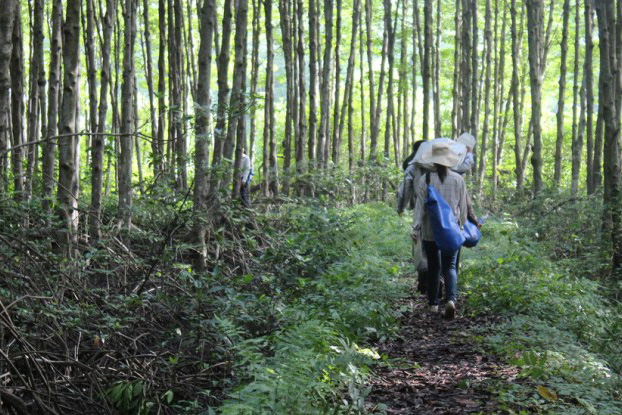
By Fidelis E. Satriastanti, originally published at CIFOR’s Forests News
Mangrove forests might account for only 0.5 percent of coastal areas worldwide, but they punch well above their weight when it comes to mitigating climate change. A recent study in Vietnam found this is true even for artificially restored mangroves.
The study assessed carbon storage in restored mangrove sites. It was a collaborative work between Nong Lam University (Vien Ngoc Nam) as host, the Center for International Forestry Research or CIFOR (Daniel Murdiyarso, Joko Purbopuspito, and Sigit Sasmito), and US Forest Service (Richard MacKenzie).
“Vietnam was a natural choice for the study: it’s home to the largest mangrove areas in the Mekong Delta, and many of its mangroves have been replanted after being heavily degraded during the Vietnam War,” said Sigit Sasmito, a researcher at CIFOR.
The study was conducted on a total of nine plots in the Can Gio Mangrove Biosphere Reserve (CGMBR) and Kien Vang Protection Forest (KVPF).
The researchers compared vegetation structure, biodiversity and carbon storage in two types of restoration sites: planted mangroves in the Can Gio Mangrove Biosphere Reserve and naturally regenerated ones in the Kien Vang Protection Forest.
In 1978, the Vietnamese government launched a reforestation program in the area. At least 20,000 hectares of mangrove forests in the area were planted with 35 mangrove species between 1978 and 1998.
Kien Vang Protection Forest, located in Ca Mau province, spans 11,274 hectares, of which 8,404 hectares have been designated as a mangrove protection area. It also experienced massive degradation throughout the war. Its forests regenerated naturally, without any human intervention.
EQUAL POTENTIAL
“Our findings imply that different restoration approaches, either artificial or natural regeneration, do not affect the capacity of mangroves to sequester carbon,” said Sasmito.
The study found that planted mangroves in the Can Gio reserve had 889 ±111 tons of carbon per hectare, very close to the naturally regenerated forests of KVPF, which had a total of 844 ±58 tons of carbon per hectare.
“The findings surprised us because we hypothesized that different mangrove restoration approaches would result in different carbon sequestration capacities,” said Sasmito.
Future projections in the study came to a similar conclusion: after 35 years, planted and naturally regenerated mangrove forests will have similar levels of carbon.
Sasmito points out that this research supports the current push to restore mangroves worldwide, by giving evidence that mangrove restoration can enhance climate change mitigation through carbon storage .
A recent CIFOR study found that Indonesia’s 2.9 million hectares of mangroves store some 3.14 billion tonnes of carbon – a huge emissions reduction, if mangrove forests are preserved.
“Our research supports previous finding that mangrove ecosystems store significant amount of carbon – up to 5 times more than tropical forests,” said Sasmito.
“This is significant for global climate change mitigation strategies,” he added.
“Mangroves with two more other coastal wetland ecosystems, namely sea grass and salt marsh, are referred to as ‘blue carbon’,” explained Sasmito.
In terms of biodiversity, the study found that the replanted mangrove plots had considerably higher mangrove species diversity, with 15 true mangrove species compared to only 12 species in the naturally regenerated areas.
“This is because artificially regenerated mangrove site is given more frequent new species introduction compare to naturally regenerated site, which species introduction is part of mangrove management and monitoring intervention,” Sasmito explained.











